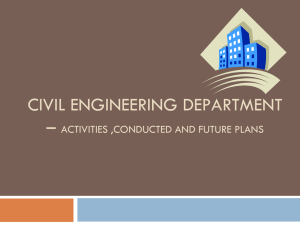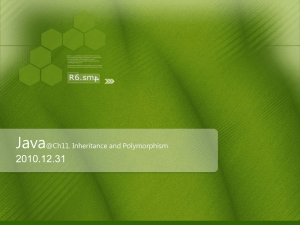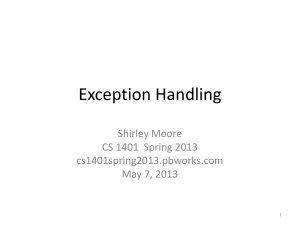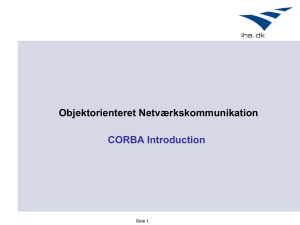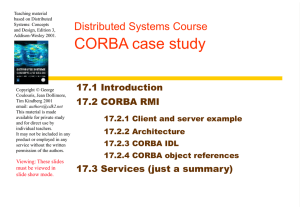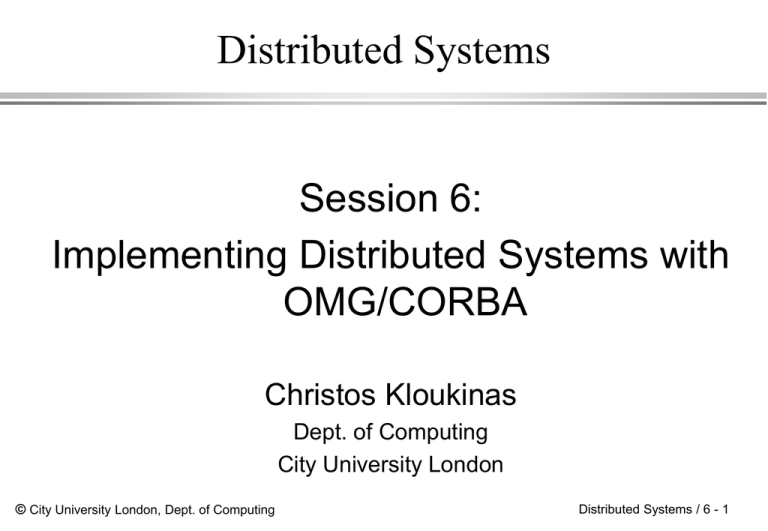
Distributed Systems
Session 6:
Implementing Distributed Systems with
OMG/CORBA
Christos Kloukinas
Dept. of Computing
City University London
© City University London, Dept. of Computing
Distributed Systems / 6 - 1
Announcements
Milestone 2 Due today
» Server Implementation
» A least version 1
» 1 submission per pair
» Identify your partner in the submission
Some Self Assessment questions up on
CitySpace
© City University London, Dept. of Computing
Distributed Systems / 6 - 2
Taking Stock: Module Outline
1 Motivation
2 Distributed Software Engineering
3 Communication
4 RMI
5 CORBA vs RMI
6 Building Distributed Systems with CORBA
-
Common Problems in Distributed Systems
7
Naming and Trading
8
Concurrent Processes and Threads
9
Transactions
10 Security
© City University London, Dept. of Computing
Distributed Systems / 6 - 3
0.0 CORBA IDL
CORBA IDL is very expressive and widely
available on many platforms for different
programming languages. This has motivated
the use of CORBA as a mechanism to explain,
study and experiment with principles of
distributed systems
© City University London, Dept. of Computing
Distributed Systems / 6 - 4
0.1 Last session: Object Management Architecture
Application
Objects
CORBA
facilities
Object Request Broker
Transactions
Naming
trading concurrency
© City University London, Dept. of Computing
Security
Lifecycle
CORBA
services
Distributed Systems / 6 - 5
0.2 Last session: CORBA Architecture
© City University London, Dept. of Computing
Distributed Systems / 6 - 6
0.3 Last session Summary
Revisited CORBA/IDL
Static Vs Dynamic Invocation
Interface Repository
Dynamic Invocation Interface (DII)
Dynamic Skeleton Interface (DSI).
Basic Object Adapter
CORBA Communication and the IIOP Protocol
Hello World Example
Compare and Contrast, CORBA and JAVA RMI
© City University London, Dept. of Computing
Distributed Systems / 6 - 7
Outline of Session 6
IDL programming language bindings.
Difference between centralised and
distributed object lifecycle.
CORBA Lifecycle Service.
© City University London, Dept. of Computing
Distributed Systems / 6 - 8
Outline
To actually develop distributed systems an IDL is not sufficient. The
operations declared at the interface need to be implemented in order to be
used.
For both implementation and use of distributed operations, bindings to
existing programming languages need to be defined. The
standardisation of these programming language bindings will then
facilitate the interoperability between distributed objects that are
implemented in different programming languages to form so called
polylingual applications.
A further prerequisite for distributed object-oriented applications is the
ability to create distributed objects in a location transparent way.
Moreover, objects may have to be copied or relocated and during that
may have to be migrated to different platforms. Also objects may have to
be removed.
© City University London, Dept. of Computing
Distributed Systems / 6 - 9
1 IDL Programming Language Bindings
1 Polylingual applications
2 Standardisation of bindings
3 Available bindings
4 What bindings need to address
5 An example: IDL/Java
© City University London, Dept. of Computing
Distributed Systems / 6 - 10
1.1 Polylingual Applications
Distributed computing frameworks, such as CORBA are not only used for
the construction and a-priori integration of new components. They are
probably more often used for the a-posteriori integration of applications
from existing components.
Polylingual applications have components in different programming
languages.
To achieve interoperability between these components, language bindings
are needed that map different language concepts onto each other.
Problem: with n different languages, n(n-1) different language bindings
needed.
Solution: One language (such as IDL) as a mediator. Requires only n
bindings.
© City University London, Dept. of Computing
Distributed Systems / 6 - 11
1.1 Polylingual Applications with IDL
Client side
•Multiple polylingual clients
accessing same object
Java
Client
IDL
Infrastructure
•IDL/JAVA binding enables client
to invoke exported operations on
server object
© City University London, Dept. of Computing
Object
Implementation
Side
IDL
C++ Obj.
Impl.
•IDL/C++ Binding used to
implement exported operations
Distributed Systems / 6 - 12
1.2 Standardisation of Bindings
Facilitate portability:
» If different ORB vendors used different programming
language bindings, neither object implementations nor
clients of these implementations would be portable. As this
is very undesirable, the OMG has standardised a number
of language bindings.
» ORB vendors must respect these language bindings to be
able to claim that they are CORBA compliant.
Decrease learning curve of developers:
» Developers who studied one language binding do not have
to learn the binding again if they switch to an ORB from
another vendor.
© City University London, Dept. of Computing
Distributed Systems / 6 - 13
1.3 Available Bindings
C
C++
Smalltalk
Ada-95
OO Cobol
Java
© City University London, Dept. of Computing
It is sufficient for the compliance of
an object request broker product to
the CORBA standard if it provides one
of these bindings.
Most brokers, however, provide more
than one binding.
Nevertheless, no product is currently
available that implements all bindings.
Distributed Systems / 6 - 14
1.4 What Bindings Need to Address
Atomic data types and type constructors
Constants
Interfaces and multiple inheritance
Object references
Attribute accesses
Operation execution requests
Exceptions
Invocation of ORB operations
© City University London, Dept. of Computing
Distributed Systems / 6 - 15
1.5 An Example: IDL/Java
1 Modules
2 Atomic Types
3 Enumerations
4 Records
5 Interfaces
6 Attributes
7 Operations
8 Inheritance
9 Exceptions
10 Operation Execution Requests
© City University London, Dept. of Computing
Distributed Systems / 6 - 16
1.5.1 Modules
As an example, assume that an interface Account is
included in the IDL BankApplication module. This
interface will be represented in Java as class
Account. From outside the package
BankApplication, the class can be accessed
using BankApplication.Account.
Note that in this way the avoidance of name
clashes is supported, which makes the approach
particularly useful for the construction of large
distributed systems.
© City University London, Dept. of Computing
Distributed Systems / 6 - 17
1.5.1 Modules
IDL:
Java:
module BankApplication {
...
};
package BankApplication;
...
© City University London, Dept. of Computing
Distributed Systems / 6 - 18
1.5.2 Atomic Types
IDL
Java
short/unsigned short
long/unsigned long
long long/unsigned long long
float
double
char
boolean
octet
string
short
int
long
float
double
char
boolean
byte
String
© City University London, Dept. of Computing
Distributed Systems / 6 - 19
1.5.2 Atomic Types (ctd.)
Most atomic types map naturally to Java
Java’s platform independence is of great value here.
In the IDL to C++ mapping, for example, there is the
problem of different representations on different
platforms (shorts can be 32 or 64 bit on Unix and 16
bit on PCs or the significance of a byte may be
different (low endian vs high endian architecture).
Therefore IDL-to-C++ does not map anything to
atomic C++ types. Java does not have this problem
because the Java Virtual Machine is standardised.
© City University London, Dept. of Computing
Distributed Systems / 6 - 20
1.5.3 Enumerations
IDL provides an enumeration type;
» An ordered list of identifiers whose values are assigned in
ascending order according to their order in enumeration
module addresses{
enum Sex {male, female};
};
Java has no enumeration type and therefore
has to implement an enumeration as a class!
The class provides constants of the enumeration
type which is internally realised as integers
Additionally the Java class provides a method to
convert integers to the enumeration type
© City University London, Dept. of Computing
Distributed Systems / 6 - 21
Enumeration (2)
One shortcoming of Java is the missing enumeration type. An IDL enumeration is mapped to an enumeration class in Java
Example: The above IDL enumeration in implemented by the Java code below. The constants can be accessed as Sex.male
and Sex.female . Integers (0 and 1 in this case) can be translated to enumeration type
package Addresses;
public final class Sex implements java.lang.Cloneable {
public static final int _male = 0;
public static final Sex male = new Sex(_male);
public static final int _female = 1;
public static final Sex female = new Sex(_female);
public static final Sex IT_ENUM_MAX = new Sex(Integer.MAX_VALUE);
public int value () {return ___value;}
public static Sex from_int (int value) {
switch (value) { case _male : return male;
case _female : return female;
default : throw new org.omg.CORBA.BAD_PARAM("Enum out of range");
}
}
private Sex (int value) { ___value = value;}
private int ___value;
public java.lang.Object clone(){return from_int(___value);}
}
© City University London, Dept. of Computing
Distributed Systems / 6 - 22
1.5.4 Records
IDL
Java
struct Info {
long height;
short weight;
};
final public class Info {
public int height;
public short weight;
public Info() {}
public Info(int height, short weight){
this.height = height;
this.weight = weight;}
};
Likewise, IDL records
are mapped to a Java
class.
Attributes of the record
are mapped to public
attributes of the class.
Names used in IDL are
used directly in Java.
© City University London, Dept. of Computing
Distributed Systems / 6 - 23
1.5.5 Interfaces
IDL interfaces are translated into Java public
interfaces. The reasons for that are obvious: The
inheritance and subtype relationships in IDL can be
mapped to inheritance in Java and interface
components, such as attributes and operations can
be implemented as Java methods.
The interface name can be kept as the class name
because no name conflicts can occur in Java which
would not have already been detected in IDL.
© City University London, Dept. of Computing
Distributed Systems / 6 - 24
1.5.6 Attributes
IDL
interface person
{
attribute readonly string name;
attribute address lives_at;
};
Java
public interface person {
public String name();
public address lives_at();
public void lives_at(address value);
};
© City University London, Dept. of Computing
Distributed Systems / 6 - 25
1.5.6 Attributes (ctd.)
IDL attributes are implemented as Java class attribute with
access methods. For readonly attributes a single (get)
method is generated and for other attributes a pair of (set and
get) methods is created.
An access of an attribute from a remote object can fail for
similar reasons as an operation execution request. These
failures are handled using exceptions in both Java and IDL.
The visibility of methods that implement attributes is public.
This is necessary to retain the IDL semantics that any
attribute that is declared can be accessed from other classes.
© City University London, Dept. of Computing
Distributed Systems / 6 - 26
1.5.7 Operations
IDL
interface Dog {
void bark(out short times);
void growl(in string at);
};
Java
public interface Dog{
public void bark(org.omg.CORBA.ShortHolder times);
public void growl(String at);
};
© City University London, Dept. of Computing
Distributed Systems / 6 - 27
1.5.7 Operations (ctd.)
Operations defined in an IDL interface are mapped to public Java
methods of the class that represents the interface.
The method name is retained because again this cannot cause scoping
problems in Java that would not have been detected in IDL. Likewise,
parameter names are retained as they cannot cause name clashes.
The mapping of parameter types is more complicated. Since Java does
NOT provide pointers, parameters of atomic type are passed by value,
IMPORTANT STUFF
Truth #1: Everything in Java is passed by value. Objects,
however, are never passed at all.., ONLY their references
are (by value again…).
Truth #2: The values of variables are always primitives or
references, never objects.
© City University London, Dept. of Computing
Distributed Systems / 6 - 28
Operations ctd. (in, out,inout parameters)
IN : to be passed with a meaningful value
» Value of the actual parameter is copied into the formal parameter when the
operation is invoked. Modification of formal parameter affects only the formal
parameter, not the actual parameter. This is the most common form of
parameter passing and is the only one provided in C & Java(CALL-BY-VALUE)
OUT: Whose value will be changed by operation
» The value of the formal parameter is copied into the actual parameter when the
procedure returns. Modifications to the formal parameter do not affect the
formal parameter until the function returns. (CALL-BY-RESULT)
» So it really should be passed by reference (to be modified!)
INOUT: Combination of IN and OUT
E.G. Consider f(s) and call f(g), s: formal parameter,and g actual
parameter
© City University London, Dept. of Computing
Distributed Systems / 6 - 29
Operations ctd (implementing out, inout)
CORBA IDL in parameter implement call-by-value semantics , JAVA
supports this, so consequently in maps to normal JAVA parameters and
requires no additional effort.
whereas IDL’s out and inout parameter do NOT have JAVA counterparts,
SO some additional mechanism is required for call-by-result, etc
Java creates for every type a holder class, a container, an object which
wraps up the value. Since object references can be passed by value the
out/inout parameter can now be realised in java programs.
I.e Clients instantiate an instance of appropriate Holder class, which is
then passed by value.
To support portable stubs and skeletons, holder classes also implement the
org.omg.CORBA.portable.Streamable interface, to allow for
marshalling and unmarshalling.
© City University London, Dept. of Computing
(The whole object is sent!)
Distributed Systems / 6 - 30
Operations (2)
•Contents of the instance are modified by server invocation
•Client then uses possibly changed contents
•The short-holder class of the above example is, for example, part of
the org.omg.CORBA package:
package org.omg.CORBA;
public final class ShortHolder
{
public short value;
public ShortHolder() {}
public ShortHolder(short s) { value = s; }
}
•In language bindings providing pointers out/inout parameters are realised by
pointers
© City University London, Dept. of Computing
Distributed Systems / 6 - 31
1.5.8 Inheritance
IDL
interface student : person
{
attribute string subject;
};
Java
public interface student extends person
{
string subject();
void subject(String value);
}
IDL provides multiple inheritance, JAVA does not.
How is the problem solved??
© City University London, Dept. of Computing
Distributed Systems / 6 - 32
1.5.8 Inheritance (ctd.)
Inheritance between IDL interfaces is implemented as inheritance
between the respective Java interfaces.
Note : Java interfaces do allow multiple inheritance whereas
Java classes do not.
Therefore IDL interfaces with multiple inheritance map to JAVA
interfaces with multiple inheritance
When implementing such a Java interface one uses the implementskeyword and therefore inherits only the names of methods and
attributes and not any code. The Java class implementing a Java
interface with multiple inheritance implements every single
method/attribute of the interface and is therefore in control.
© City University London, Dept. of Computing
Distributed Systems / 6 - 33
1.5.9 Exceptions
IDL
Java
interface employee : person {
exception too_young{...};
void retire() raises (too_young);
};
public interface Employee
extends org.omg.CORBA.Object {
public void retire() throws
EmployeePackage.too_young;
}
Exceptions that are declared within an interface are mapped to Java
classes.
© City University London, Dept. of Computing
Distributed Systems / 6 - 34
Exceptions (2)
The previous example leads to the following Java class:
package Exception.EmployeePackage;
public final class too_young
extends org.omg.CORBA.UserException
implements java.lang.Cloneable {
public String explanation;
public short age;
public too_young() {super();}
public too_young(String explanation,short age) {
super(); this.explanation = explanation; this.age = age;}
...}
Note that programming languages such as C which do not provide
exceptions, model exceptions by additional parameters to methods.
(much faster but easier to ignore…)
© City University London, Dept. of Computing
Distributed Systems / 6 - 35
1.5.10 Operation Execution Requests
Operation execution requests have no
counterpart in IDL as IDL is an interface and
not an implementation definition language!
© City University London, Dept. of Computing
Distributed Systems / 6 - 36
1.5.10 Operation Execution Requests
Java
employee emp;
...
try {
emp.retire();
}
catch (too_young e){
// Handle the Specific Exception
}
catch (SystemException se){
switch (SysEx.minor() ) {
case BAD_PARAM : ... ; break;
case NO_MEMORY : ... ; break;
};
};
© City University London, Dept. of Computing
Distributed Systems / 6 - 37
2 Lifecycle Service
Application
Objects
CORBA
facilities
Object Request Broker
Lifecycle
© City University London, Dept. of Computing
CORBA
services
Distributed Systems / 6 - 38
Introduction/Summary
The problem of distributed object life cycle is the
problem of
» Creating an Object, Deleting an Object, Moving and Copying
an object, Operating on a graph of distributed objects.
Client model of object lifecycle is based on
» Factories and target objects supporting LifeCycleObject
interface which defines operation for delete, move and copy
GenericFactory interface is defined
» Generic factory is sufficient to create objects of different types
» By Defining GenericFactory interface, implementations that
administer resources are enabled.
© City University London, Dept. of Computing
Distributed Systems / 6 - 39
2.1 Introduction
Component creation in a distributed system is more
complicated than in a centralised system mainly because:
» 1) Often the component is to be created on a non-local machine. The component
creation mechanisms available in programming languages (such as
constructors in Java) cannot be used because location specification has to be
included.
» 2) Location has to be identified, and identification must be transparent
More problems arise for duplication and migration of
components
» due to potentially heterogeneous source and target platform, also 2) above
The deletion of components is more difficult as well.
» Garbage collection techniques assume that all objects are available in one
address space. This is not the case in a distributed system. The techniques
cannot be directly applied.
© City University London, Dept. of Computing
Distributed Systems / 6 - 40
2.1 Introduction (ctd.)
creation
Client
Obj1
duplication
migration
removal
Obj1
© City University London, Dept. of Computing
Obj1
Obj1
replication
Obj2
Obj1
Server
Obj1
Obj1
Obj1
Obj3
Distributed Systems / 6 - 41
2.2 CORBA Lifecycle Service Object Creation
Object creation is done in the CORBA lifecycle service by so called
Factory objects. These are plain CORBA objects themselves that
export an operation that create and return new objects.
The factory objects use object constructors for the implementation of
these creation operations. The new objects, therefore, run in the same
address space as the factory object.
An example is the personFactory object which can be used to create a
new object of type person. To do so a client who wishes to create a
person object calls the operation createPerson which will return a
reference to a newly created person object. This person object will run on
the same machine as the object of type personFactory.
The problem of location transparency then gets down to locating factory
objects.
© City University London, Dept. of Computing
Distributed Systems / 6 - 42
2.2 Object Creation (ctd.)
Object Creation is done in CORBA lifecycle service by factory objects
The life cycle module exports the FactoryFinder interface, which
supports factory location.
A client wishing to locate a factory can invoke the find_factories
operation, which will return a sequence of Factory objects. The parameter
of the find_factory operation is a key that can be considered as an
external (and location independent) name. If no factories are found with
that name, the NoFactory exception will be raised.
Factories register with a factory finder using a private protocol. This
protocol is likely to be defined in an interface that inherits from the
FactoryFinder interface.This, however, is transparent for clients.
Factory finders are not only used for the immediate location of a factory
(for creation purposes), but they are also used as proxies (placeholders)
for location information that is to be passed to move and copy operations.
© City University London, Dept. of Computing
Distributed Systems / 6 - 43
2.2 Object Creation
Factory location supported by:
interface FactoryFinder {
Factories find_factories (in Key factory_key)
raises (NoFactory);
};
Factory finder objects can be located by other
means (e.g. naming or trading).(will discuss in
next lecture)
© City University London, Dept. of Computing
Distributed Systems / 6 - 44
2.2 Object Creation (ctd.)
It would be fairly costly if a factory interface had to be created for each object
type. This would immediately double the number of interfaces in the distributed
application.
The life cycle service therefore defines the GenericFactory interface. It
exports an operation by means of which it can be checked whether the Factory
is able to create an object of a particular type (whose name is given as a key).
A second operation allows clients to create an instance of the type whose
name is given as a key.
This overcomes the problem that type specific factories are not needed. In
addition, resources can be managed for instances of different types that reside
on one location.
As a disadvantage, however, a type specific initialisation (which can be
achieved within an object constructing operation of a specific factory) is not
possible through this generic interface.
© City University London, Dept. of Computing
Distributed Systems / 6 - 45
2.2 Object Creation
LifeCycle Service includes generic factory:
interface GenericFactory {
boolean supports(in Key k);
Object create_object(in Key k, in NVP criteria)
raises (NoFactory, InvalidCriteria,
CannotMeetCriteria);
};
Advantage: no type specific factories required.
Disadvantage: No specific initialisations.
© City University London, Dept. of Computing
Distributed Systems / 6 - 46
Example
import org.omg.CosNaming.*; import org.omg.CosLifeCycle.*;
import org.omg.CORBA.*;
//1) Instantiating the factory from an interoperable object reference stored in file
String factoryIOR;
factoryIOR = getFactoryIOR("genfac.ior");
org.omg.CORBA.Object genFacRef = orb.string_to_object(factoryIOR);
GenericFactory fact = GenericFactoryHelper.narrow(genFacRef);
//2) Using the factory to create an object
// struct NameComponent { Istring id; Istring kind; };
NameComponent nc = new NameComponent("sBuyer::BuyerServer",
"object interface");
NameComponent key[] = {nc};
NVP mycriteria[] = {};
org.omg.CORBA.Object objRef = fact.create_object(key, mycriteria);
Buyer1Ref = BuyerHelper.narrow(objRef);
© City University London, Dept. of Computing
Distributed Systems / 6 - 47
2.3 Object Duplication
The interface to duplicate objects is in LifeCycleObject.
» The copy operation takes a FactoryFinder as a parameter. This factory finder
defines the (set of) locations on which the copy should be created.
Object types that are to be copied or moved around to other
locations have to be subtypes of LifeCycleObject.
To accomplish type specific implementations of the copy operation
while retaining a unique and generic interface that is seen by
clients, subtypes of LifeCycleObject redefine the copy
operation.
interface LifeCycleObject {
LifeCycleObject copy (in FactoryFinder there)
raises (NoFactory,...);
...
};
© City University London, Dept. of Computing
Distributed Systems / 6 - 48
2.3 Object Duplication
The copying of an object cannot be implemented by the
ORB.
» It uses the factory to create a new object on the target machine. In this
way, the problem of heterogeneous machine code of object
implementations is resolved.
Attribute values are transferred either
» through parameters of the object constructing operation
» through explicit operation invocations done after the object has been
made. This way heterogeneity of data representation is resolved
© City University London, Dept. of Computing
Distributed Systems / 6 - 49
2.4 Object Deletion
Objects that are created also have to be removed. In many object
oriented programming languages this is done implicitly as the
object is no longer referenced.
This requires reference counting and garbage collection techniques
which are not applicable to distributed objects because they are too
expensive in a distributed setting!
Deletion of an object is defined in the LifeCycleObject interface as
well. To free the resources allocated by an object clients explicitly
invoke the remove operation.
interface LifeCycleObject {
void remove() raises (NotRemovable);
};
© City University London, Dept. of Computing
Distributed Systems / 6 - 50
2.5 Object Migration
Migration is the removal of an object implementation from one
location to another location.
The client view of migration is also defined by the
LifeCycleObject interface by means of the move operation.
Interfaces defining specific objects that inherit from
LifeCycleObject redefine move in an application specific way! It
is often possible to use the copy and the remove operation for that
purpose. This, however, is not done generically, as more efficient
ways may be possible in application specific situations.
interface LifeCycleObject {
void move(in FactoryFinder there)
raises(NoFactory,NotMovable);
};
© City University London, Dept. of Computing
Distributed Systems / 6 - 51
2.6 What’s Missing: Replication
No relationship is maintained between two objects once they have
been copied. They therefore do not evolve together but are
completely independent from each other.
This means that the life cycle service does not support replication
and therefore replication transparency is not support in the CORBA
framework.
There are integrations of particular CORBA products (Orbix, for
instance) with replication middleware components (ISIS). These
integrations, however, are not standardised and applications that use
them will not be portable.
The advantages of replication are that it allows for a higher load and
also it supports fault tolerance because the state of an object can
be recovered from a replica if an implementation has crashed.
© City University London, Dept. of Computing
Distributed Systems / 6 - 52
4 Summary
Polylingual applications.
IDL programming language bindings.
Difference between centralised and distributed
object lifecycle.
CORBA Lifecycle Service.
© City University London, Dept. of Computing
Distributed Systems / 6 - 53
EXTRA GOODIES
(Do read these…)
© City University London, Dept. of Computing
Distributed Systems / 6 - 54
3 Static vs. Dynamic Invocation
Client
Dynamic
Invocation
Client
Stubs
Object Implementation
ORB
Interface
Server
Skeleton
Object
Adapter
ORB Core
© City University London, Dept. of Computing
Distributed Systems / 6 - 55
3.1 Generic Applications
Example: Object Browser
Generic applications
use components whose
types are not (yet)
known.
© City University London, Dept. of Computing
Person
Name:
Celia Cruz
Age:
56
Distributed Systems / 6 - 56
3.2 Static Invocation
Advantages:
» Requests are simple to define.
» Availability of operations checked by programming
language compiler.
» Requests can be implemented fairly efficiently.
Disadvantages:
» Generic applications cannot be build.
» Recompilation required after operation interface
modification.
© City University London, Dept. of Computing
Distributed Systems / 6 - 57
3.3 Dynamic Invocation Interface
Interface to create operation execution requests
dynamically.
Requests are objects.
Attributes for operation name, parameters and
results.
Operations to
» change operation parameters,
» issue the request and
» obtain the request results.
© City University London, Dept. of Computing
Distributed Systems / 6 - 58
3.4 Creation of Requests
interface Object {
ORBstatus create_request (
in Context ctx,
in Identifier operation,
in NVList arg_list,
inout NamedValue result,
out Request request
in Flags req_flags
);
...
};
© City University London, Dept. of Computing
//
//
//
//
//
//
operation context
operation to exec
args of operation
operation result
new request object
request flags
Distributed Systems / 6 - 59
3.5 Synchronous Requests
Server
Client
invoke
© City University London, Dept. of Computing
Distributed Systems / 6 - 60
3.6 Deferred Synchronous Requests
Server
Client
send
get_response
© City University London, Dept. of Computing
Distributed Systems / 6 - 61
3.7 Interface Repository
Makes type information of interfaces available
at run-time.
Enables development of generic applications.
Achieves type-safe dynamic invocations.
Supports construction of interface browser.
Used by ORB itself.
© City University London, Dept. of Computing
Distributed Systems / 6 - 62
3.8 Locating Interface Definitions
Alternatives for locating interface definitions:
Any interface inherits the operation
InterfaceDef get_interface() from Object.
Associative search using lookup_name.
Navigation through the interface repository
using contents and defined_in attributes.
© City University London, Dept. of Computing
Distributed Systems / 6 - 63
3.9 Example: Object Browser
Person
Name:
Celia Cruz
Age:
56
© City University London, Dept. of Computing
Use interface repository
to find out about object
types at run-time
Use dynamic invocation
interface to obtain
attribute values.
Distributed Systems / 6 - 64
3.10 Object Browser Interaction Diagram
Object
InterfaceDef
Request
Request
get_interface()
name()
describe_interface()
create_request()
invoke()
create_request()
invoke()
© City University London, Dept. of Computing
Distributed Systems / 6 - 65
4 Summary
Polylingual applications.
IDL programming language bindings.
Difference between centralised and distributed
object lifecycle.
Dynamic vs static invocation
CORBA Lifecycle Service.
© City University London, Dept. of Computing
Distributed Systems / 6 - 66





